The Influence of Copper Substrates on Irradiation Effects of Graphene: A Molecular Dynamics Study
Abstract
1. Introduction
2. Materials and Methods
3. Results and Discussion
4. Conclusions
Author Contributions
Funding
Conflicts of Interest
References
- Novoselov, K.S.; Geim, A.K.; Morozov, S.V.; Jiang, D.; Zhang, Y.; Dubonos, S.V.; Grigorieva, I.V.; Firsov, A.A. Electric Field Effect in Atomically Thin Carbon Films. Science 2004, 306, 666–669. [Google Scholar] [CrossRef] [PubMed]
- Naumis, G.G.; Barraza-Lopez, S.; Oliva-Leyva, M.; Terrones, H. Electronic and optical properties of strained graphene and other strained 2D materials: A review. Rep. Prog. Phys. Phys. Soc. 2017, 80, 096501. [Google Scholar] [CrossRef] [PubMed]
- Dontschuk, N.; Stacey, A.; Tadich, A.; Rietwyk, K.J.; Schenk, A.; Edmonds, M.T.; Shimoni, O.; Pakes, C.I.; Prawer, S.; Cervenka, J. A graphene field-effect transistor as a molecule-specific probe of DNA nucleobases. Nat. Commun. 2015, 6, 6563. [Google Scholar] [CrossRef] [PubMed]
- Wu, Y.; Yao, B.; Yu, C.; Rao, Y. Optical Graphene Gas Sensors Based on Microfibers: A Review. Sensors 2018, 18, 941. [Google Scholar] [CrossRef] [PubMed]
- Ci, L.; Song, L.; Jin, C.; Jariwala, D.; Wu, D.; Li, Y.; Srivastava, A.; Wang, Z.F.; Storr, K.; Balicas, L.; Liu, F. Atomic layers of hybridized boron nitride and graphene domains. Nat. Mater. 2010, 9, 430–435. [Google Scholar] [CrossRef]
- Brito, W.H.; Kagimura, R.; Miwa, R.H. B and N doping in graphene ruled by grain boundary defects. Phys. Rev. B 2012, 85, 035404. [Google Scholar] [CrossRef]
- Stegmann, T.; Franco-Villafane, J.A.; Kuhl, U.; Mortessagne, F.; Seligman, T.H. Transport gap engineering by contact geometry in graphene nanoribbons: Experimental and theoretical studies on artificial materials. Phys. Rev. B 2017, 95, 035413. [Google Scholar] [CrossRef]
- Kang, B.; Kim, H.; Han, J.T.; Kim, D.G.; Cho, K. Controllable Bipolar Doping of Graphene with 2D Molecular Dopants. Small 2018, 14, 1703697. [Google Scholar] [CrossRef]
- Wehling, T.O.; Novoselov, K.S.; Morozov, S.V.; Vdovin, E.E.; Katsnelson, M.I.; Geim, A.K.; Lichtenstein, A.I. Molecular doping of Graphene. Nano Lett. 2008, 8, 173–177. [Google Scholar] [CrossRef]
- Li, H.; Daukiya, L.; Haldar, S.; Lindblad, A.; Sanyal, B.; Eriksson, O.; Aubel, D.; Hajjar-Garreau, S.; Simon, L.; Leifer, K. Site-selective local fluorination of graphene induced by focused ion beam irradiation. Sci. Rep. 2016, 6, 19719. [Google Scholar] [CrossRef]
- Balan, A.; Rodriguez-Manzo, J.A.; Puster, M.; Drndic, M. Effect of defects produced by electron irradiation on the electrical properties of graphene. In Proceedings of the APS March Meeting, San Antonio, TX, USA, 2–6 March 2015. [Google Scholar]
- Imamura, G.; Saiki, K. Effect of UV light-induced nitrogen doping on the field effect transistor characteristics of graphene. RSC Adv. 2015, 5, 70522–70526. [Google Scholar] [CrossRef]
- Francis, S.A.; James, C.P.; John, W.M.; Cory, D.C. Effects of Proton and X-ray Irradiation on Graphene Field-Effect Transistors with Thin Gate Dielectrics. IEEE Trans. Nucl. Sci. 2014, 61, 3010–3017. [Google Scholar] [CrossRef]
- Dumée, L.F.; Feng, C.; He, L.; Yi, Z.; She, F.; Peng, Z.; Gao, W.; Banos, C.; Davies, J.B.; Huynh, C.; Hawkins, S. Single step preparation of meso-porous and reduced graphene oxide by gamma-ray irradiation in gaseous phase. Carbon 2014, 70, 313–318. [Google Scholar] [CrossRef]
- Tung, T.T.; Alotaibi, F.; Nine, M.J.; Silva, R.; Tran, D.N.; Janowska, I.; Losic, D. Engineering of highly conductive and ultra-thin nitrogen-doped graphene films by combined methods of microwave irradiation, ultrasonic spraying and thermal annealing. Chem. Eng. J. 2018, 338, 764–773. [Google Scholar] [CrossRef]
- Zhao, D.; Liu, H.; Wang, Q.; Wang, S.; Fei, C.; Chen, S. Multiscale simulations of swift heavy ion irradiation effect on bilayer graphene. IEICE Electron. Express 2016, 13, 20151040. [Google Scholar] [CrossRef]
- Zhao, S.; Xue, J.J.C. Modification of graphene supported on SiO2 substrate with swift heavy ions from atomistic simulation point. Carbon 2015, 93, 169–179. [Google Scholar] [CrossRef]
- Wu, P.; Zhang, Y.; Cui, P.; Li, Z.; Yang, J.; Zhang, Z. Carbon Dimers as the Dominant Feeding Species in Epitaxial Growth and Morphological Phase Transition of Graphene on Different Cu Substrates. Phys. Rev. Lett. 2015, 114, 216102. [Google Scholar] [CrossRef] [PubMed]
- Stubrov, Y.; Nikolenko, A.; Strelchuk, V.; Nedilko, S.; Chornii, V. Structural Modification of Single-Layer Graphene Under Laser Irradiation Featured by Micro-Raman Spectroscopy. Nanoscale Res. Lett. 2017, 12, 297. [Google Scholar] [CrossRef] [PubMed]
- Zhao, D.; Liu, H.; Wang, Q.; Wang, S.; Fei, C.; Chen, S. Molecular dynamics simulation of latent track formation in bilayer graphene. IEICE Electron. Express 2015, 12, 20150771. [Google Scholar] [CrossRef]
- Bellido, E.P.; Seminario, J.M. Molecular dynamics simulations of ion-bombarded graphene. J. Phys. Chem. C 2012, 116, 4044–4049. [Google Scholar] [CrossRef]
- Pei, Q.; Zhang, Y.; Shenoy, V.J.C. A molecular dynamics study of the mechanical properties of hydrogen functionalized graphene. Carbon 2010, 48, 898–904. [Google Scholar] [CrossRef]
- Wu, X.; Zhao, H.; Zhong, M.; Murakawa, H.; Tsukamoto, M.J.C. Molecular dynamics simulation of graphene sheets joining under ion beam irradiation. Carbon 2014, 66, 31–38. [Google Scholar] [CrossRef]
- Ong, Z.-Y.; Pop, E. Molecular dynamics simulation of thermal boundary conductance between carbon nanotubes and SiO2. Phys. Rev. B 2010, 81, 155408. [Google Scholar] [CrossRef]

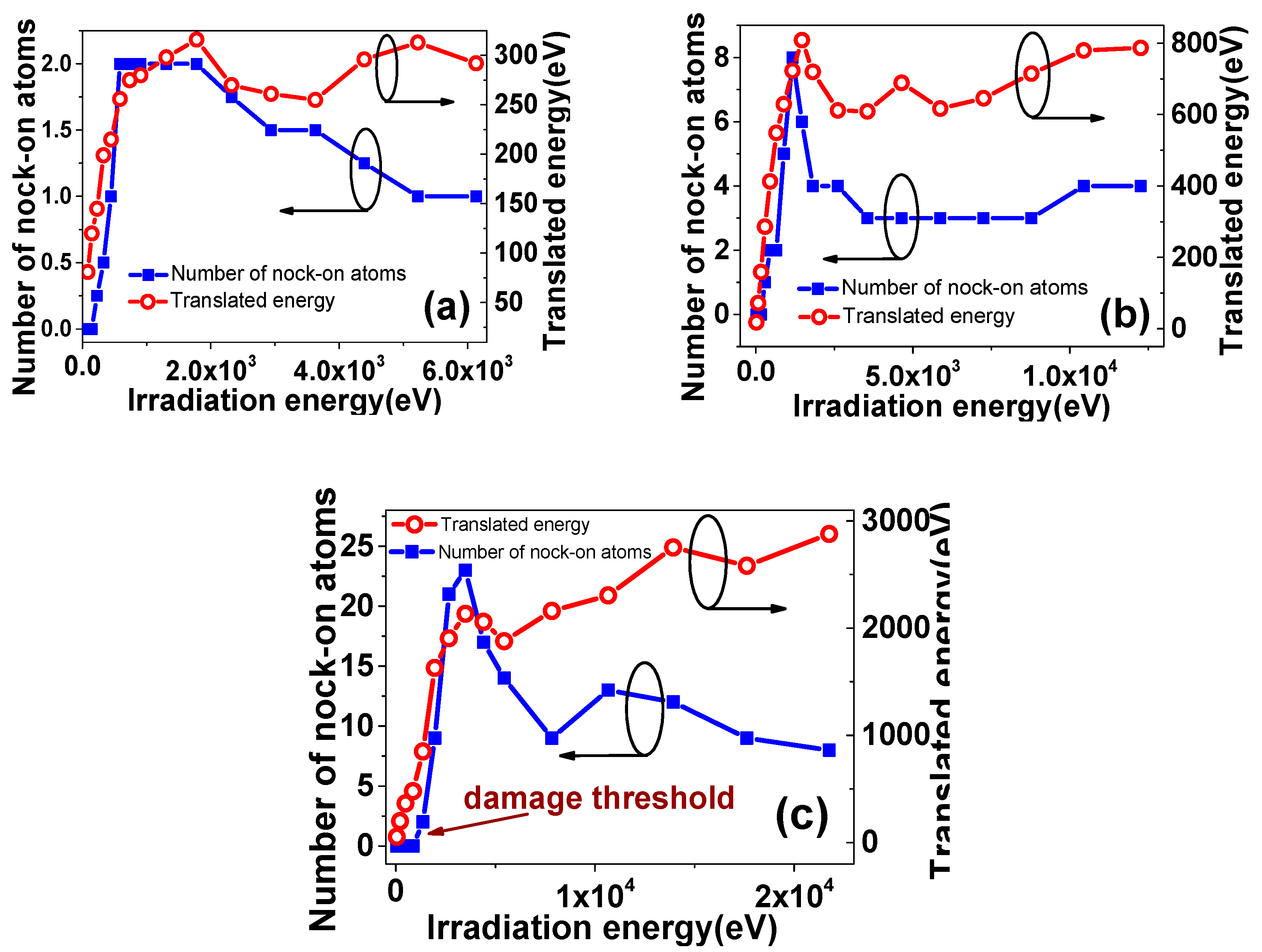
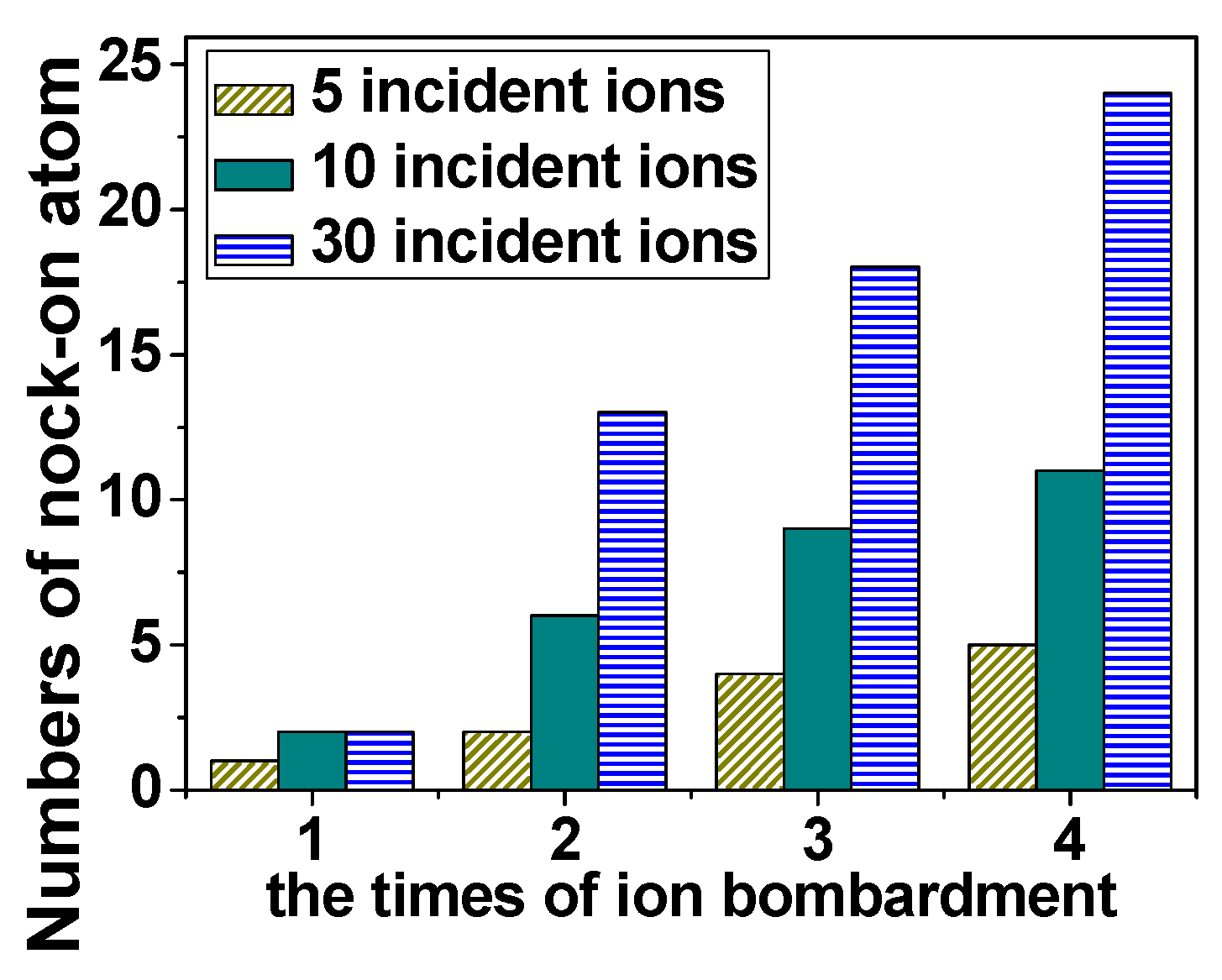
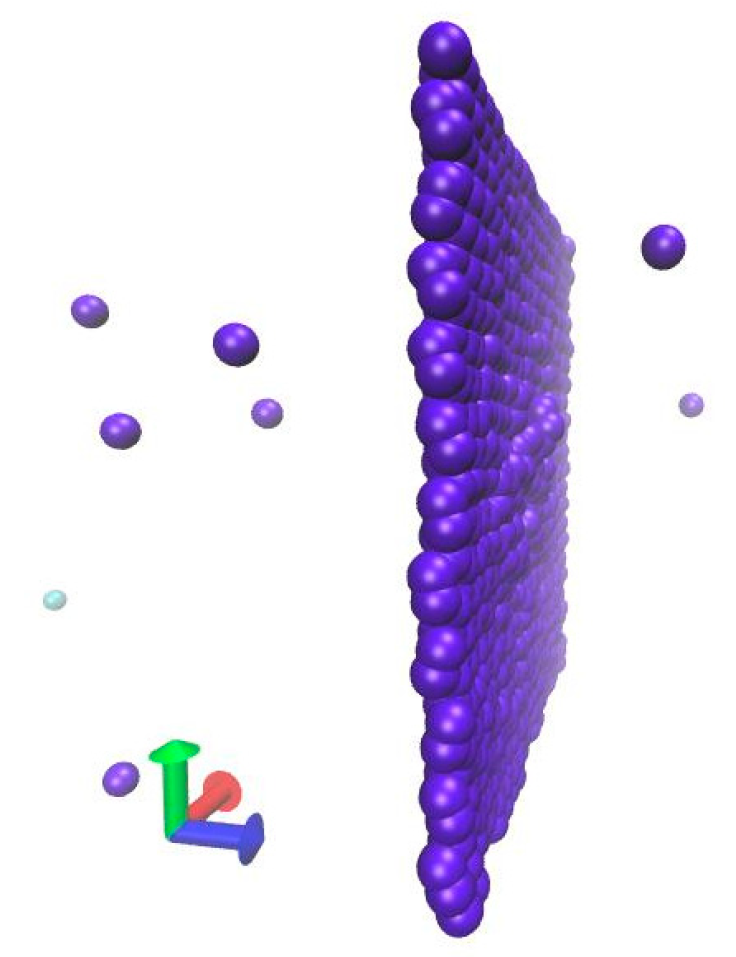
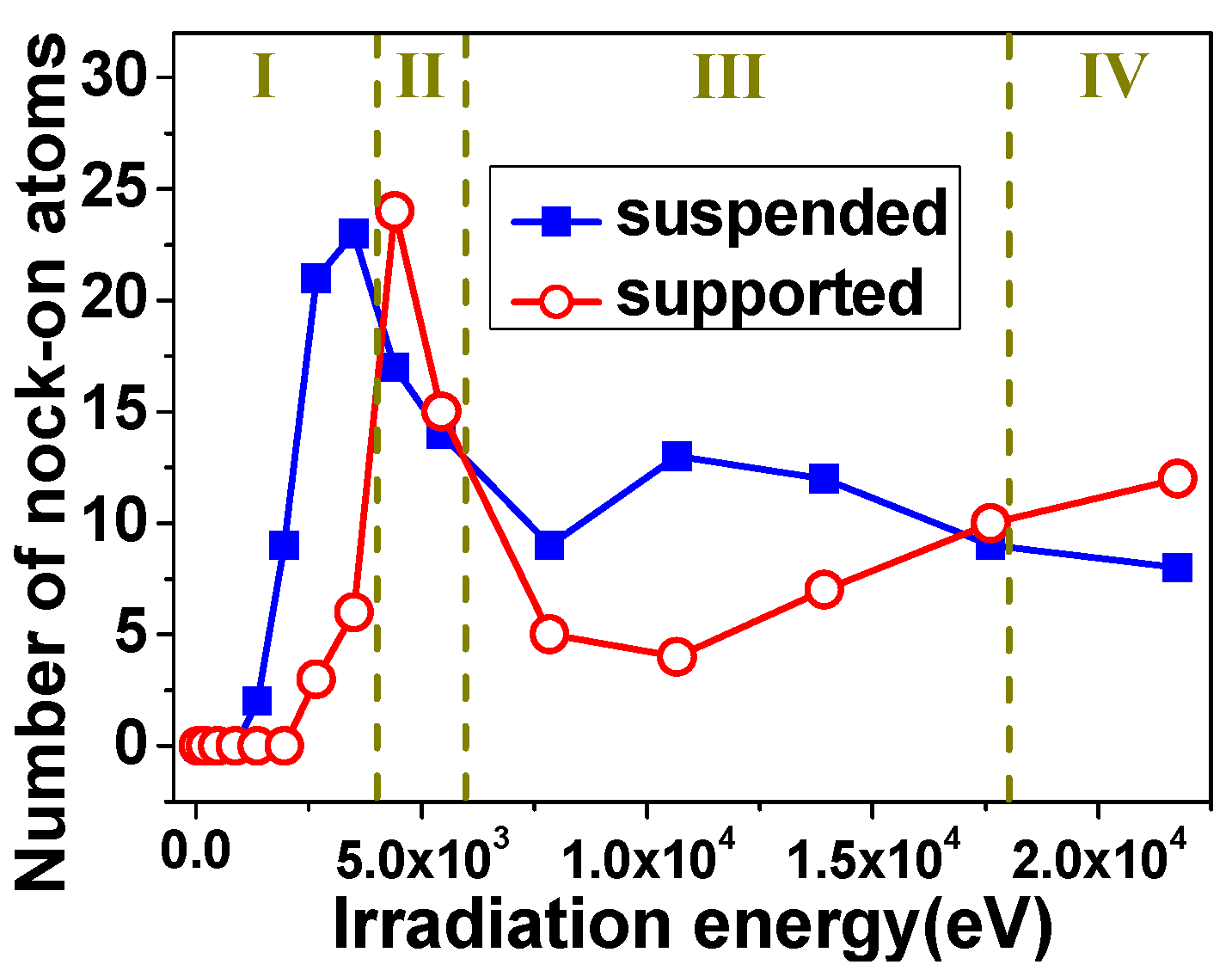
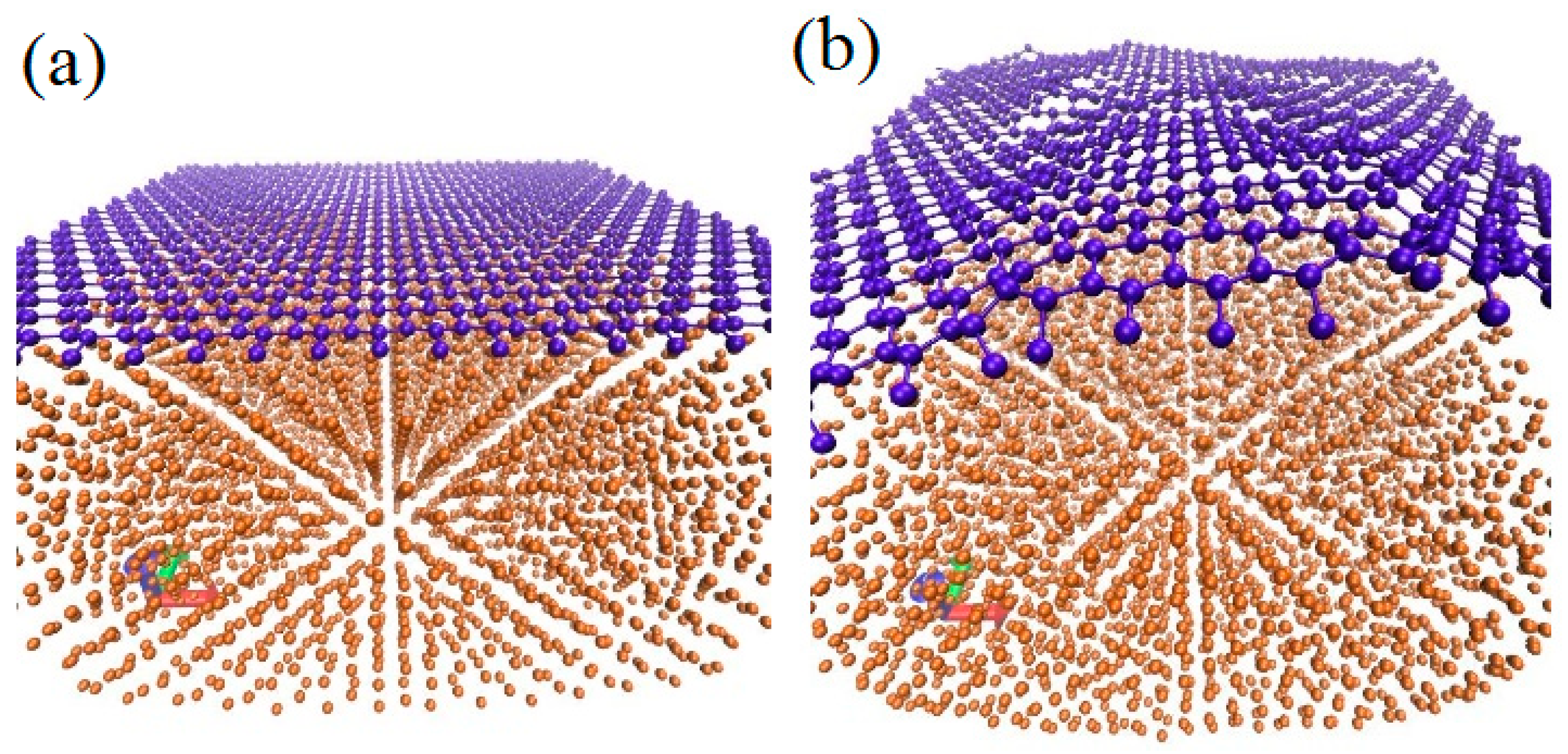
© 2019 by the authors. Licensee MDPI, Basel, Switzerland. This article is an open access article distributed under the terms and conditions of the Creative Commons Attribution (CC BY) license (http://creativecommons.org/licenses/by/4.0/).
Share and Cite
Wang, S.; Zhang, Q.; Yin, K.; Gao, B.; Zhang, S.; Wang, G.; Liu, H. The Influence of Copper Substrates on Irradiation Effects of Graphene: A Molecular Dynamics Study. Materials 2019, 12, 319. https://doi.org/10.3390/ma12020319
Wang S, Zhang Q, Yin K, Gao B, Zhang S, Wang G, Liu H. The Influence of Copper Substrates on Irradiation Effects of Graphene: A Molecular Dynamics Study. Materials. 2019; 12(2):319. https://doi.org/10.3390/ma12020319
Chicago/Turabian StyleWang, Shulong, Qian Zhang, Kai Yin, Bo Gao, Siyu Zhang, Guoping Wang, and Hongxia Liu. 2019. "The Influence of Copper Substrates on Irradiation Effects of Graphene: A Molecular Dynamics Study" Materials 12, no. 2: 319. https://doi.org/10.3390/ma12020319
APA StyleWang, S., Zhang, Q., Yin, K., Gao, B., Zhang, S., Wang, G., & Liu, H. (2019). The Influence of Copper Substrates on Irradiation Effects of Graphene: A Molecular Dynamics Study. Materials, 12(2), 319. https://doi.org/10.3390/ma12020319






